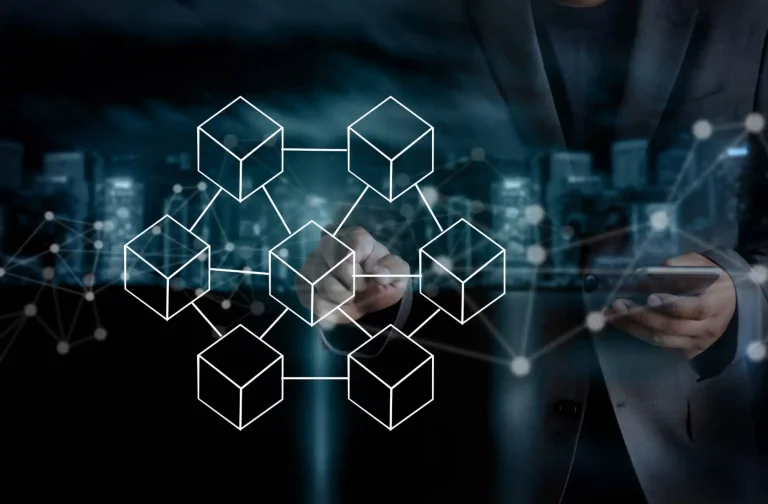
Blockchain Layers Explained And How They Work: A Simple Guide!
Blockchain technology has made all kinds of cool things possible.
It’s the tech behind cryptocurrency and all the decentralized fun that comes with it. It also gave birth to the new proof of ownership capabilities that spawned the NFT revolution.
Different technologies had to unite for blockchain technology to work as a concept.
Today, we’re going to dive into the different levels of the blockchain and find out how they all work together. You may have heard crypto enthusiasts using terms like Level 1 and Level 2 blockchain – but what exactly do they mean?
You’re about to find out as we break down what each mysterious piece of the blockchain puzzle brings to the table.
What’s The Purpose Of Blockchain Layers?
Before we delve into the blockchain’s various levels, let’s first establish why layers are required.
It all goes back to the dream of the ideal blockchain. In a perfect world, a single blockchain would be capable of nailing three functions:
What is Blockchain Decentralization
Decentralization means that overall network has control, instead of one entity or organization.
It is a concept that aims to distribute authority, power, and decision-making responsibilities away from a centralized entity and towards the individual nodes or participants in the network.
This is achieved through the use of decentralized networks, which are designed to minimize the degree of trust that users must place in one another.
This prevents any single user from abusing their power or influence in a way that could negatively impact the network’s performance.
In a blockchain, data is stored in a database that is spread across multiple network nodes.
These nodes can be computers or other devices running blockchain software, located in various places. This distribution of data not only ensures the integrity of the data but also adds redundancy.
For instance, if an attempt is made to alter a record at one instance of the database, the other nodes in the network would prevent this alteration from happening. This ensures that no single node within the network has the power to change the information held within it.
In essence, decentralization in blockchain refers to the shift of authority and decision-making from a single, centralized entity to a distributed network of nodes.
This ensures a more democratic and transparent system where power and control are distributed among the participants of the network. This is one of the key features that make blockchain technology so revolutionary and impactful.
What is Blockchain Security
Blockchain Security refers to a comprehensive risk management solution for a blockchain network. It aims fight against online fraud, security breaches, and other attacks by leveraging assurance services, cybersecurity frameworks, and best practices.
All blockchains are powered by Distributed Ledger Technology (DLT), but not all of them offer the same level of safety or operational soundness. The security models of public and private blockchain networks differ fundamentally due to their open vs closed nature. Each type of blockchain has its own set of advantages and disadvantages.
In the context of public blockchains, the open nature allows anyone to participate, which can lead to increased threats. On the other hand, private blockchains are closed and only allow authorized participants, which can enhance security but limit accessibility.
However, regardless of the type of blockchain, security is a critical aspect.
Blockchain security involves the use of best practices, advanced technologies, and cybersecurity principles to minimize risk and prevent unauthorized access and harmful attacks on blockchain networks.
It ensures the integrity and reliability of the blockchain, making it a key component in the successful implementation and operation of blockchain technology.
What is Blockchain Scalability
Scalability refers to a network’s ability to keep up with increasing demand without negative tradeoffs.
It refers to the ability of a blockchain to handle and process a large number of transactions quickly.
In the context of blockchain, scalability primarily relates to transaction throughput, which is the number of transactions a system can process per second.
As of now, the speed of cryptocurrency transactions is not as fast as traditional financial systems, making scalability a significant hurdle for the wider adoption of blockchain technology.
Despite these challenges, ongoing research and development efforts are aimed at enhancing the scalability of blockchain networks.
Blockchain’s scalability is one of the biggest challenges in the field of cryptocurrencies, largely due to a concept known as the ‘trilemma’. Because of blockchain’s unique formation, it’s difficult to accommodate decentralization, scalability, and security all at the same time.
So how do blockchains accomplish all three goals; simultaneously?
The truth is, they don’t. At least not yet.
What Is The Blockchain Trilemma?
Enter a concept known as the “Blockchain Trilemma.” First coined by Ethereum founder Vitalik Buterin, the trilemma argues that most blockchains can only hope to achieve two of these three supreme goals simultaneously.
Major blockchains like Ethereum and Bitcoin have always put security and decentralization at the head of the pack. But as a result, they’re still trying to fine-tune scalability solutions.
Nonetheless, using different layers has already gone a long way toward getting blockchain technology to where it is today. While some layers are essential, others help increase the scalability of specific networks.
It’s important to note that the scalability trilemma is based on observations from the Buterin and Web3 communities, and it’s not an absolute rule. There could be an algorithm that exists which can solve this trilemma unless it’s proven to be impossible.
Blockchain Layers Explained – What Are The Blockchain Layers
Admittedly, blockchain technology isn’t always the most straightforward concept to wrap your head around. So, let’s break things down via the power of metaphor.
Imagine, if you will, that the average blockchain is operating as a business in the real world.
Got it? Good.
Layer 0
Layer 0 is to the blockchain what architectural components are to the average building. While physical facilities consist of materials like concrete and steel, Layer 0 consists of technological components.
These include hardware, peer-to-peer connectivity capabilities, and other protocols required to make a decentralized ecosystem possible.
But the average office building isn’t just designed to look pretty; its purpose is to provide people with a place to build a business.
Same thing with Layer 0 protocols like Polkadot, Cardano, and Avalanche. These blockchains are platforms companies can build other blockchains or applications on – a place to set up shop.
Layer 0 also allows cross-chain interoperability, enabling various blockchains to communicate.
Layer 1
If Layer 0 is our office building, Layer 1 is the company that operates inside it. Layer 1 is where a blockchain becomes Bitcoin or Ethereum by laying out its policies and procedures.
It’s where everything from consensus mechanisms to programming languages is established and carried out. Layer 1 also encompasses the security measures that ensure the blockchain runs smoothly and orderly.
On the downside, some security protocols, such as Proof-of-Work (PoW), can also be where scalability issues come into play. Such is what led to the Ethereum Merger of 2022.
Ethereum was initially built on a PoW system which worked out okay. But eventually, its popularity began to outgrow the number of miners available to validate network transactions.
This tremendous workload resulted in insanely high gas fees, slower processing times, and overall scalability failure. That’s why ETH has decided to kick PoW to the curb in favor of a new Proof-of-Stake system.
Layer 2
So how does Layer 2 fit in with our business metaphor? Imagine that the Layer 1 business inside our Layer 0 building is starting to find itself stretched a little thin.
The building is not large enough to accommodate any additional resources. So, that’s when our blockchain business comes up with an innovative solution.
We’ll build additional space on top of the existing building for a third party that can move in to help handle the workflow. This, in essence, is the idea of Layer 2 protocols, such as Bitcoin’s Lightning Network.
Level 2 protocols, or L2 solutions, are different networks operating on L1 bases. L2s constantly communicate with L1 and exist to help improve scalability.
Providing additional nodes and handling specific interactions frees L1 to focus on only the most vital tasks.
Layer 3
When you walk into the average business, you rarely see many of the internal operations that keep the whole thing up and running. Mostly, you stick to the storefront that the company has set up for customers.
Level 3 is that storefront. It comprises the interfaces that users interact with when placing day-to-day blockchain trades.
When you log into your wallet or trading platform, you interact with Level 3, whether you know what it’s called or not. The truth is that there are plenty of users around the world who are blissfully unaware that the blockchain even has different levels.
Which is not all that odd when you think about it. After all, when was the last time you took a backstage tour of the factory that made the clothes you’re wearing?
Why does all this matter?
People tend to care less about how a business runs and more about what it offers. Nonetheless, understanding a company from the inside out can have its perks, particularly when it comes to investing.
While most customers could care less about significant company operations changes, the same news could be precious among its shareholders.
Even something like the announcement of a new CEO can drastically affect a company’s stock value. Same thing with cryptocurrency.
Many Ethereum holders may not even know about ETH’s upcoming merger. But insiders who understand the significance of its upcoming Level 2 changes will likely be a lot less confused if the token’s value is affected one way or the other.
Sources
https://coinstats.app/blog/what-are-blockchain-layers-and-how-do-they-work/
https://www.blockchain-council.org/blockchain/layers-of-blockchain-technology/
https://www.makeuseof.com/layer-1-vs-layer-2-blockchain-layers-explained-simply/
https://academy.binance.com/en/articles/blockchain-layer-1-vs-layer-2-scaling-solutions





I blog frequently and I seriously appreciate your information. This article has truly peaked my interest. I’m going to take a note of your site and keep checking for new details about once per week. I opted in for your Feed too.
Thanks! If there’s anything in Crypto/Web3 space you want to know more about, let us know. [email protected]. We’ll happily break it down for you.
You ought to take part in a contest for one of the best sites on the web. I most certainly will recommend this blog!
We’re a group of volunteers and opening a new scheme in our community. Your website provided us with valuable info to work on. You have done an impressive job and our entire community will be thankful to you.
Thanks for finally talking about > blog_title < Loved it!
I have been surfing online greater than three hours lately, but I never discovered any interesting article like yours. It’s lovely worth sufficient for me. Personally, if all website owners and bloggers made excellent content material as you probably did, the net will be much more helpful than ever before.
Magnificent site. Lots of helpful information here. I’m sending it to several friends ans also sharing in delicious. And certainly, thank you for your sweat!
Hey I know this is off topic but I was wondering if you knew of any widgets I could add to my blog that automatically tweet my newest twitter updates. I’ve been looking for a plug-in like this for quite some time and was hoping maybe you would have some experience with something like this. Please let me know if you run into anything. I truly enjoy reading your blog and I look forward to your new updates.
It’s not my first time to go to see this web site, i am browsing this web site dailly and obtain good facts from here all the time.